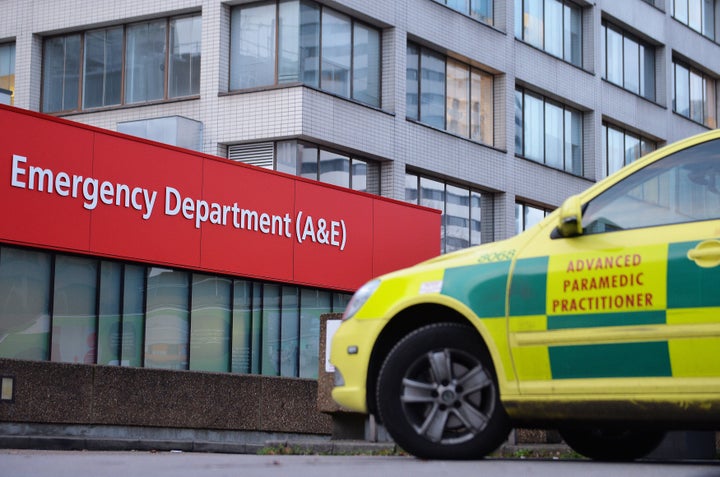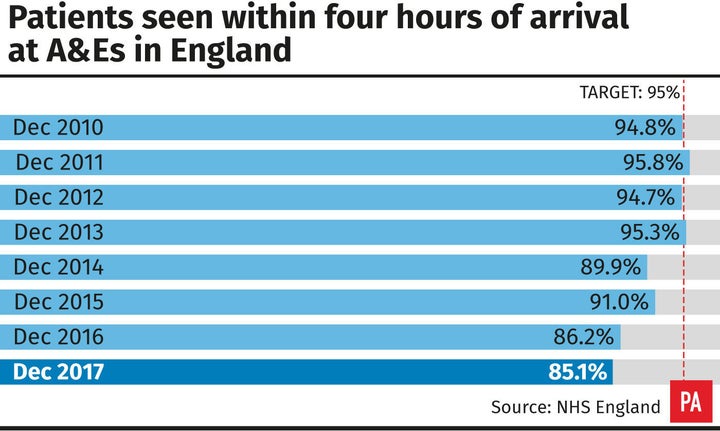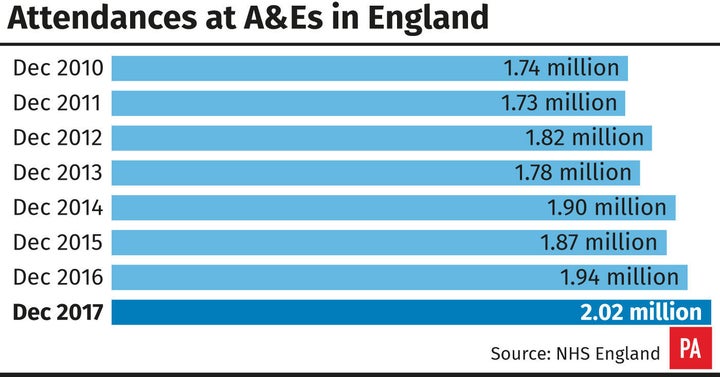
- Target of seeing 95% of patients within four hours not met since 2015
- Just 77.3% of A&E patients at major A&E departments seen within target
- Blackpool Teaching Hospitals is worst performer hitting just 40% of target
A group of more than 60 senior A&E doctors have warned Theresa May that patients are “dying prematurely” in hospital corridors amid “intolerable” safety risks, as NHS England figures reveal that waiting times have reached the worst level on record.
In a letter to the Prime Minister published in the Health Service Journal, signatories warned that thousands of patients are left stuck in the back of ambulances waiting to be taken into A&E, while it can take up to 12 hours to transfer a patient admitted to hospital to a bed.
Statistics released today showed that just 85.1% of A&E patients were seen within four hours in December 2017, falling significantly short of the NHS target of 95%, meaning 300,000 patients waited too long for care.
In December 2016, 86.2% of A&E patients were seen in time, meaning the NHS success rate has fallen by 1.1% in just 12 months.
Levels have only dipped so low once before since monthly reporting on the four-hour target was introduced in 2010, with rates also reaching 85.1% in January 2017.
The 95% target has not been met now since July 2015.

A&E workers told HuffPost UK this week that pressure on the frontline is so intense that patients are waiting 10 hours to be seen by a doctor, while doctors and nurses are suffering from anxiety and depression as a result.
“This year, with the current degree of winter pressure that we are feeling, this is the worst condition that I have ever seen the NHS in,” Dr Adrian Harrop, an A&E doctor at Scarborough Hospital, said.
“A&E is not a destination in itself, it is like a sorting office.”
The Royal College of Surgeons called December’s A&E performance “disappointing”.
The body warned that just 77.3% of emergency patients at major A&E departments were seen within the time frame in December.
“Despite the best efforts and dedication of NHS staff to treat patients quickly, waiting times for non-urgent care have also deteriorated again in the past year,” a spokesperson said.
“The fact remains that we do not have adequate funding or capacity in our health or social care services.”
Worst-performing major A&E departments
(Percentage of patients seen within four hours - NHS England target is 95%)
Blackpool Teaching Hospitals NHS Foundation Trust - 40.1%
The Hillingdon Hospitals NHS Foundation Trust - 57.6%
Royal Cornwall Hospitals NHS Trust - 57.8%
London North West Healthcare NHS Trust - 58.7%
University Hospitals Of North Midlands NHS Trust - 59%
Blackpool Teaching Hospitals NHS Foundation Trust was flagged as the worst-performing major A&E department, known as “type 1” units within the NHS, with just 40.1% of patients being seen within four hours in December.
Cancer Care And Referral To Treatment Targets Also Take Hit
Today’s stats also reveal that cancer care targets have taken a hit - just 82.5% of patients received their first treatment within 62 days of referral.
According to NHS outlines, 85% of patients should be treated within this time.
Meanwhile, referral to treatment figures show that, of the 3.2 million patients on the waiting list for treatment at the end of November 2017, just 89.5% had been waiting less than 18 weeks.
This is significantly lower than the NHS goal standard of 92% and compares to 90.5% at the end of November 2016.
Plus, 1.7% of the patients waiting for one of the 15 key diagnostic tests at the end of November 2017 had been waiting six weeks or longer from referral, compared to the 1% operational standard.
The figures come after struggling hospitals were told on New Years Day to cancel all routine surgery until the end of January amid fears of a meltdown, with as many as 55,000 operations affected by the move.

Today, NHS Providers warned Health Secretary Jeremy Hunt that the health service will fail to deliver “the care we need as a nation” without more money.
A spokesperson for the Department of Health and Social Care said: “We know the NHS is extremely busy, which is why it was given top priority in the recent Budget with an extra £2.8 billion allocated over the next two years – and despite the extra pressure that comes with winter, including rising flu levels, hardworking staff treated 55,328 people within four hours every single day in December - 1,272 more each day than in the same month the previous year.
“The Government also supported the NHS this winter with an additional £437million of funding.”
